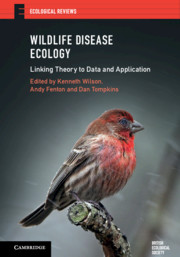Book contents
- Wildlife Disease Ecology
- Ecological Reviews
- Wildlife Disease Ecology
- Copyright page
- Contents
- Contributors
- Preface: Wildlife Disease Ecology
- Glossary of Terms
- Part I Understanding within-host processes
- Chapter one Pollinator diseases: the Bombus–Crithidia system
- Chapter Two Genetic diversity and disease spread: epidemiological models and empirical studies of a snail–trematode system
- Chapter Three Wild rodents as a natural model to study within-host parasite interactions
- Chapter Four From population to individual host scale and back again: testing theories of infection and defence in the Soay sheep of St Kilda
- Chapter Five The causes and consequences of parasite interactions: African buffalo as a case study
- Chapter Six Effects of host lifespan on the evolution of age-specific resistance: a case study of anther-smut disease on wild carnations
- Chapter Seven Sexually transmitted infections in natural populations: what have we learnt from beetles and beyond?
- Part II Understanding between-host processes
- Part III Understanding wildlife disease ecology at the community and landscape level
- Index
- Plate Section (PDF Only)
- References
Chapter one - Pollinator diseases: the Bombus–Crithidia system
from Part I - Understanding within-host processes
Published online by Cambridge University Press: 28 October 2019
- Wildlife Disease Ecology
- Ecological Reviews
- Wildlife Disease Ecology
- Copyright page
- Contents
- Contributors
- Preface: Wildlife Disease Ecology
- Glossary of Terms
- Part I Understanding within-host processes
- Chapter one Pollinator diseases: the Bombus–Crithidia system
- Chapter Two Genetic diversity and disease spread: epidemiological models and empirical studies of a snail–trematode system
- Chapter Three Wild rodents as a natural model to study within-host parasite interactions
- Chapter Four From population to individual host scale and back again: testing theories of infection and defence in the Soay sheep of St Kilda
- Chapter Five The causes and consequences of parasite interactions: African buffalo as a case study
- Chapter Six Effects of host lifespan on the evolution of age-specific resistance: a case study of anther-smut disease on wild carnations
- Chapter Seven Sexually transmitted infections in natural populations: what have we learnt from beetles and beyond?
- Part II Understanding between-host processes
- Part III Understanding wildlife disease ecology at the community and landscape level
- Index
- Plate Section (PDF Only)
- References
Summary
Several species of Crithidia are gut parasites of bumble bees (Bombus spp.), their main effect being to castrate the queens emerging from hibernation. The parasites are common in natural populations, spread among colonies and host species by shared use of flowers. Infection prevalence varies on a small geographic scale and over years, with no clear pattern. Genetic analyses of C. bombi show that mixed-genotype infections of single host individuals are common, associated with a high rate of sexual reproduction inside the host. Parasite populations are genotypically highly diverse, with up to 30 concurrent infections, such that the same genotype is rarely found more than once in a sample. A hallmark of this system is that a given parasite genotype infects only a certain range of host genotypic backgrounds, and this range varies among parasite genotypes. Hosts are susceptible to a limited range of parasite genotypes. A major defence Bombus uses against Crithidia is deployment of anti-microbial peptides (AMPs), which have been characterised with release of the Bombus genome. AMPs have synergistic effects. Queen mothers can also protect their offspring, the workers in the colony, by trans-generational immune priming.
Keywords
- Type
- Chapter
- Information
- Wildlife Disease EcologyLinking Theory to Data and Application, pp. 3 - 31Publisher: Cambridge University PressPrint publication year: 2019
References
- 10
- Cited by



